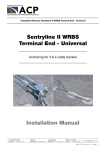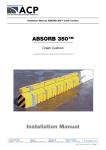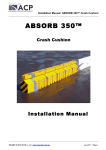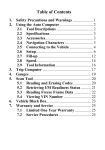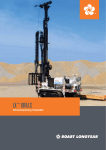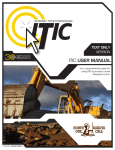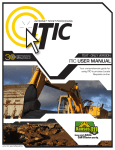Download Sentryline II Cable Barrier Installation Manual
Transcript
Installation Manual: Sentryline II Cable Barrier Sentryline II Cable Barrier Test Level 3 - 3 & Test Level 4 - 4 Cable Systems Installation Manual New South Wales Sydney 02 9772 4172 Victoria Melbourne 03 9213 5199 Queensland Brisbane 07 3271 9133 Western Austalia Perth 04 1743 0230 www.acprod.com.au ACP | 28th January 2011 | Page 1 Installation Manual: Sentryline II Cable Barrier Table of contents Introduction 3 Safety statements 3 Before installation 4 Tension 4 Tools required 4 Intermediate anchors 5 Batter hinge point 5 Parts identification 6 Bill of materials 7 Installation instructions 8 Installation examples 15 Installation checklist 16 Appendix – technical drawings Sentryline II Test Level 3 - 3 cable line post set up 18 Sentryline II Test Level 4 - 4 cable line post set up 18 Sentryline II WRBS Terminal End - Universal overlap 18 New South Wales Sydney 02 9772 4172 Victoria Melbourne 03 9213 5199 Queensland Brisbane 07 3271 9133 Western Austalia Perth 04 1743 0230 www.acprod.com.au ACP | 28th January 2011 | Page 2 Installation Manual: Sentryline II Cable Barrier Sentryline II Cable Barrier System - Introduction Safety statements General safety Test Level 3 – 3 Cable barrier The Sentryline II TL-3 barrier is a 3 cable, high tension cable barrier. The system has been designed and tested to meet the evaluation criteria of NCHRP 350 Test Level 3 (TL-3) for a longitudinal barrier. When correctly installed it is capable of stopping, containing or redirecting an errant vehicle in a safe manner under NCHRP 350 impact conditions. Those conditions are an 820kg passenger car and a 2,000kg pickup truck impacting at 20 and 25 degrees at a speed of 100kph. » All required traffic safety precautions should be complied with. All workers should wear required safety clothing - high visibility vests, steel capped footwear, gloves, hard hats, safety glasses etc. » Only authorised trained personnel should operate any machinery. Where overhead machinery is used, care must be taken to avoid any overhead hazards. » Before auguring, always have the area checked for underground services by the appropriate service providers. » Gloves should be worn at all times. Test Level 4 – 4 Cable barrier The Sentryline II TL-4 barrier is a 4 cable, high tension cable barrier. The system has been designed and tested meet of the evaluation criteria of NCHRP 350 Test Level 4 (TL-4) for a longitudinal barrier. When correctly installed it is capable of stopping, containing or redirecting an errant vehicle in a safe manner under NCHRP 350 impact conditions. Those conditions are an 820kg passenger car, 2,000kg pickup truck and an 8,000kg truck impacting at 20, 25 and 15 degrees at a speed of 100kph and 80kph. New South Wales Sydney 02 9772 4172 Victoria Melbourne 03 9213 5199 Sentryline II safety statements » All installers must be well clear of machinery while the holes are augured. » The posts and components are easily lifted and positioned by hand, while the cable and reel are extremely heavy so it is recommended that the cable is run out on a heavy duty, single axis spindle. » Avoid placing hands or fingers in and around moving parts when components are being lifted and manoeuvred into place. » Only trained personnel should use the tensioning machine. All installers must be extremely careful they are clear of moving parts when the hydraulic ram is being operated. Queensland Brisbane 07 3271 9133 Western Austalia Perth 04 1743 0230 www.acprod.com.au ACP | 28th January 2011 | Page 3 Installation Manual: Sentryline II Cable Barrier Before installation Tension Design, selection and placement of the Sentryline II shall be in accordance with the local road authority guidelines and the details shown in the construction drawings. Installation shall be in accordance with the installation instructions supplied for this product. It is important that when tensioning the Sentryline II cable barrier that the tension machine is set correctly. The tension machine is usually set to 25kN’s (for 21-26°C days) but may need to be changed to reflect the air temperature at the time of installation as shown in the table below. Advice should be sought on all installations from your Sentryline II distributor. Before installing a Sentryline II cable barrier, ensure that all components required for the system are on site and have been identified. The Sentryline II is a highly engineered safety device made up of relatively small number of parts. Before starting installation ensure that one is familiar with the make up of the system. Refer to the ‘Bill of materials’ and ‘Parts identification’ sections in this manual for more information. Depending on the application, post spacing and circumstances at the site, installation and assembly of the system should take a 2 person crew less than 2 hours to cast the piles, install the posts and place the cables for a 100m section. It is essential that the Sentryline II is installed correctly. Please carefully read and understand the following instructions before installing the Sentryline II. These instructions relate only to the installation of Sentryline II and are for standard installations only. Tension bays Required at a minimum of every 450m or as often as is necessary to correctly tension the system. When installing the strong backs, care must be taken to cut the cables mid span between posts so that the installed strong backs do not coincide with the line posts. Note: Do not place two strong backs within 30m of each other when on the same cable. Tools required The tools required to install the Sentryline II cable barrier are: » Auger for drilling 300mm holes » Machinery capable of lifting the cable reel and a single axle spindle » 300mm Wrench » Measuring tape and marker pen » String line » Cut off saw » Tensioning machine Tension Table Temp ºC (air) 0-3 4-9 10-14 15-20 21-26 26-32 33-37 38-43 Tension kN’s 32 30.5 28.5 26.5 25 23.2 21.5 19.5 New South Wales Sydney 02 9772 4172 Victoria Melbourne 03 9213 5199 Queensland Brisbane 07 3271 9133 Western Austalia Perth 04 1743 0230 www.acprod.com.au ACP | 28th January 2011 | Page 4 Installation Manual: Sentryline II Cable Barrier Intermediate anchors Intermediate anchors should be placed at a minimum of every 1,000m to properly anchor the ends of each barrier run and maintain tension. To create an intermediate anchor, simply overlap one barrier run with the next. A minimum 300mm gap between the barriers is required. Terminate each barrier with terminal end so that the Lengths of Need (LoN’s) line up. (See drawing in the appendix on page 18) Figure A Batter hinge point NCHRP 350 recommends that the lateral extent of the soil, outside an envelope of the embedded portion of the test article, be approximately 1.3 times the embedment length. ie: The standard Sentryline II footing is 750mm deep therefore requiring a minimum of 1 metre supporting soil outside the line of posts. (shown in figure A) Note: If the batter hinge point is reduced to only 600mm, then increase the standard footing depth to 1,000mm. (Shown in figure B) Figure B New South Wales Sydney 02 9772 4172 Victoria Melbourne 03 9213 5199 Queensland Brisbane 07 3271 9133 Western Austalia Perth 04 1743 0230 www.acprod.com.au ACP | 28th January 2011 | Page 5 Installation Manual: Sentryline II Cable Barrier Sentryline II - Parts identification » Line post & ‘O’ ring » Cable grip (required as per spacing specified) (6 required per tension bay) » Post cap » Strong back » Post socket (1 required per post) (3 required per tension bay) (1 required per post) » 3 Cable barrier (3 x length of barrier required) » 4 Cable barrier (4x length of barrier required) » Rebar ring (1 required per post) All steel components used in the Sentryline II are hot dipped galvanised, except the rebar ring which are cast into the concrete piles. New South Wales Sydney 02 9772 4172 Victoria Melbourne 03 9213 5199 Queensland Brisbane 07 3271 9133 Western Austalia Perth 04 1743 0230 www.acprod.com.au ACP | 28th January 2011 | Page 6 Installation Manual: Sentryline II Cable Barrier Sentryline II – Bill of materials Components required for each post: Cable Grips and associated components: » 1 x Galvanised line post (powder coating is optional) » 1 x Plastic cap » 1 x Plastic socket » 1 x Rebar ring » 1 x Rubber ‘o’ ring TL3 - 3 Cable barrier » 6 x Cable Grips c/w M20 nuts for each tension bay TL4 - 4 Cable barrier » 8 x Cable grips c/w M20 nuts for each tension bay Cable required for both TL-3 and TL-4 systems: TL-3 - 3 Cable barrier » 3 x the total length of the barrier of 19mm cable Note: There may be more than 1 tension bay per barrier run depending on the length or design of the barrier. Concrete required for each post: » 1 x 0.053m³ 25 MPa concrete TL-4 - 4 Cable barrier » 4 x the total length of the barrier of 19mm cable Note: This is the theoretical volume only and that allowance must be made that the holes may be larger than this due to the act of drilling and removing spoil. Note: It pays to be conservative with these lengths. Strong Backs required for both TL-3 and TL-4 systems: TL-3 - 3 Cable barrier » 3 x Strong backs for each tension bay TL-4 - 4 Cable barrier » 4 x Strong backs for each tension bay Note: There may be more than 1 tension bay per barrier run depending on the length or design of the barrier. New South Wales Sydney 02 9772 4172 Victoria Melbourne 03 9213 5199 Queensland Brisbane 07 3271 9133 Western Austalia Perth 04 1743 0230 www.acprod.com.au ACP | 28th January 2011 | Page 7 Installation Manual: Sentryline II Cable Barrier Sentryline II - Installation instructions It is preferred that the Sentryline II is installed on flat, level ground (minor site grading may be required) with sufficient distance behind the foundation piles as described in the ‘batter hinge point’ section of this Installation Manual. The Sentryline II barrier starts at post #5 (where post #1 is the trigger post of the Sentryline II WRBS Terminal End - Universal with post spacing as described in the construction drawings. (The first 4 line posts after the trigger post are always at 2m spacing) Before drilling always have the area checked for underground services Step 2 – Drilling the holes Figure 1 ‘Standard’ footing pile Using an auger, drill 300mm diameter holes 750mm deep (shown in Figure 1 & 2) at the spacing as shown in the construction drawings. Theoretical volume of concrete required for each pile is 0.053m³. N.B. Due to the drilling and removing spoil, the actual amount of concrete required is likely to be larger than the theoretical volume. NOTE: If the conditions on site don’t allow for a 750mm hole it may be possible to use a ‘shallow’ option. Soil tests will need to be carried out and the required soil strength present. For more details on this ‘shallow’ option and all other ‘alternative’ options consult the ‘footings’ section under ‘design considerations’ in the Sentryline II Product Manual. New South Wales Sydney 02 9772 4172 Victoria Melbourne 03 9213 5199 Figure 2 Queensland Brisbane 07 3271 9133 Western Austalia Perth 04 1743 0230 www.acprod.com.au ACP | 28th January 2011 | Page 8 Installation Manual: Sentryline II Cable Barrier Step 3 - Construction Fill the holes to within 100mm of the top with 25mpa concrete, place the rebar ring in the centre of the footing taking care to ensure that the ring is centred in the hole and level. (shown in figure 3) A string line and level are useful to ensure this. Fill the remainder of the hole with concrete until flush with grade. (shown in figure 4) New South Wales Sydney 02 9772 4172 Push plastic socket into centre of the footing until the top edge of the socket is flush with the top of the concrete. (shown in figure 5) Alignment of the socket is important so use of a string line and level, or some other suitable installation method, is required. Note: To prevent the possibility of a socket ‘floating’ use a stiff mix of concrete or place a post in the socket. (shown in figure 6) Figure 3 Figure 5 Figure 4 Figure 6 Victoria Melbourne 03 9213 5199 Queensland Brisbane 07 3271 9133 Western Austalia Perth 04 1743 0230 www.acprod.com.au ACP | 28th January 2011 | Page 9 Installation Manual: Sentryline II Cable Barrier Step 4 – Installing the posts Push a rubber ‘o’ ring onto the bottom of the post by approximately 350mm. This will prevent debris from building up in the socket which can make removal difficult. (shown in figure 7) Slide a post into the socket once the concrete has set and adjust the ‘o’ ring so that it fills the gap between the post and post socket. (shown in figure 8) Ensure that the side slots in the post are aligned so that the orientation of the two slots are consistent. (shown in figure 9) Figure 7 Figure 8 Figure 9 New South Wales Sydney 02 9772 4172 Victoria Melbourne 03 9213 5199 Queensland Brisbane 07 3271 9133 Western Austalia Perth 04 1743 0230 www.acprod.com.au ACP | 28th January 2011 | Page 10 Installation Manual: Sentryline II Cable Barrier Step 5 – Installing the cables Using a truck or trailer fitted with a cable reel frame, run the cables out to the desired length. (shown in figure 10) One or more of the cables may be run out at the same time depending on the installer’s equipment. (shown in figure 11) For a 3 cable system place the bottom 2 cables into the bottom slots on either side of the post and the top cable into the top slot. (shown in figure 12) For a 4 cable system place the bottom 2 cables into the bottom slots on either side of the post and the top 2 cables into the top slot. Ensure that the cable is pushed fully down to the bottom of the slots. (shown in figure 13) New South Wales Sydney 02 9772 4172 Figure 10 Figure 12 Figure 11 Figure 13 Victoria Melbourne 03 9213 5199 Queensland Brisbane 07 3271 9133 Western Austalia Perth 04 1743 0230 www.acprod.com.au ACP | 28th January 2011 | Page 11 Installation Manual: Sentryline II Cable Barrier Step 6 – Placing the post caps Slide the cap down the inside of the post and push down until cap is pushed hard home onto the top of the post. (shown in figure 14) Note: Make sure that cap sleeves are on the outside of the 2 cables in the bottom slots. (shown in figure 15) Step 7 – Connecting to the cable barrier terminal end Connect the cables to the terminal end as per the manufacturer’s instructions. The Sentryline II WRBS Terminal End - Universal is the recommended terminal end for Sentryline II cable barriers. (shown in figure 16) Figure 14 Figure 16 Figure 15 New South Wales Sydney 02 9772 4172 Victoria Melbourne 03 9213 5199 Queensland Brisbane 07 3271 9133 Western Austalia Perth 04 1743 0230 www.acprod.com.au ACP | 28th January 2011 | Page 12 Installation Manual: Sentryline II Cable Barrier Step 8 – Connecting the cable grips At the desired location, cut the cable using a cut off wheel in a grinder (treat cut end of cables with a zinc containing paint). Mark the cable with a marker pen 75mm from the cut end. (shown in figure 17 & 18) Now push the cable end into the cable grip and ‘jiggle’ a few times until hard home and the mark previously placed on the cable is flush with the mouth of the fitting. (shown in figure 19) Note: If the cable has just been unwrapped and still has an oily residue on it, wipe with a cloth before fitting the cable grip. It is acceptable for the cable to ease out of the cable grip up to 10mm when tensioned. If the cable has eased out more than 10mm, remove the Cable Grip and refit. (shown in figure 20) Figure 17 Figure 19 Max 10mm Figure 18 New South Wales Sydney 02 9772 4172 Victoria Melbourne 03 9213 5199 Figure 20 Queensland Brisbane 07 3271 9133 Western Austalia Perth 04 1743 0230 www.acprod.com.au ACP | 28th January 2011 | Page 13 Installation Manual: Sentryline II Cable Barrier Step 9 – Tensioning the barrier Note: Tension is dependant on temperature, therefore it may be necessary to adjust the tension applied to suit the temperature. (refer to the ‘System design’ section of the Sentryline II Product Manual for more information) Ensure full tension machine training, including safe use, has been completed before using the following methodology to tension the cable barrier. Tension machine and on site training is available from Australian Construction Products Pty Ltd. It is recommended that the supplied Sentryline II tension machine is used. Tensioning is achieved by pulling the cables together using an appropriately placed strong back and cable grip assembly. Place the cable grips and strong back into the tension machine ensuring that the cable is held in place by the safety catches. Once all personnel’s hands are clear, activate the tension machine so that it contracts, pulling the cable grips together and hence tensions the cables. The tension machine is pre-set to stop at 25kN. New South Wales Sydney 02 9772 4172 Victoria Melbourne 03 9213 5199 Run nuts up onto the threaded section of the cable grips inside the strong backs by using a ring spanner. (shown in insert below) Take care not to place fingers between nut and turnbuckle end. Extend the tension machine so that the cable grip and strong back are holding the cable under tension. Remove the tension machine and repeat until all cables have been tensioned using the same technique. Queensland Brisbane 07 3271 9133 Western Austalia Perth 04 1743 0230 www.acprod.com.au ACP | 28th January 2011 | Page 14 Installation Manual: Sentryline II Cable Barrier Sentryline II - Installation examples » Sentryline II Test Level 3 – 3 Cable Barrier » Sentryline II Test Level 4 – 4 Cable Barrier New South Wales Sydney 02 9772 4172 Victoria Melbourne 03 9213 5199 Queensland Brisbane 07 3271 9133 Western Austalia Perth 04 1743 0230 www.acprod.com.au ACP | 28th January 2011 | Page 15 Installation Manual: Sentryline II Cable Barrier Appendix – Technical drawings » 3 cables line post set up » 4 cables line post set up » Sentryline II WRBS Terminal End - Universal – Overlapping Sentryline II cable New South Wales Sydney 02 9772 4172 Victoria Melbourne 03 9213 5199 Queensland Brisbane 07 3271 9133 Western Austalia Perth 04 1743 0230 www.acprod.com.au ACP | 28th January 2011 | Page 16
















